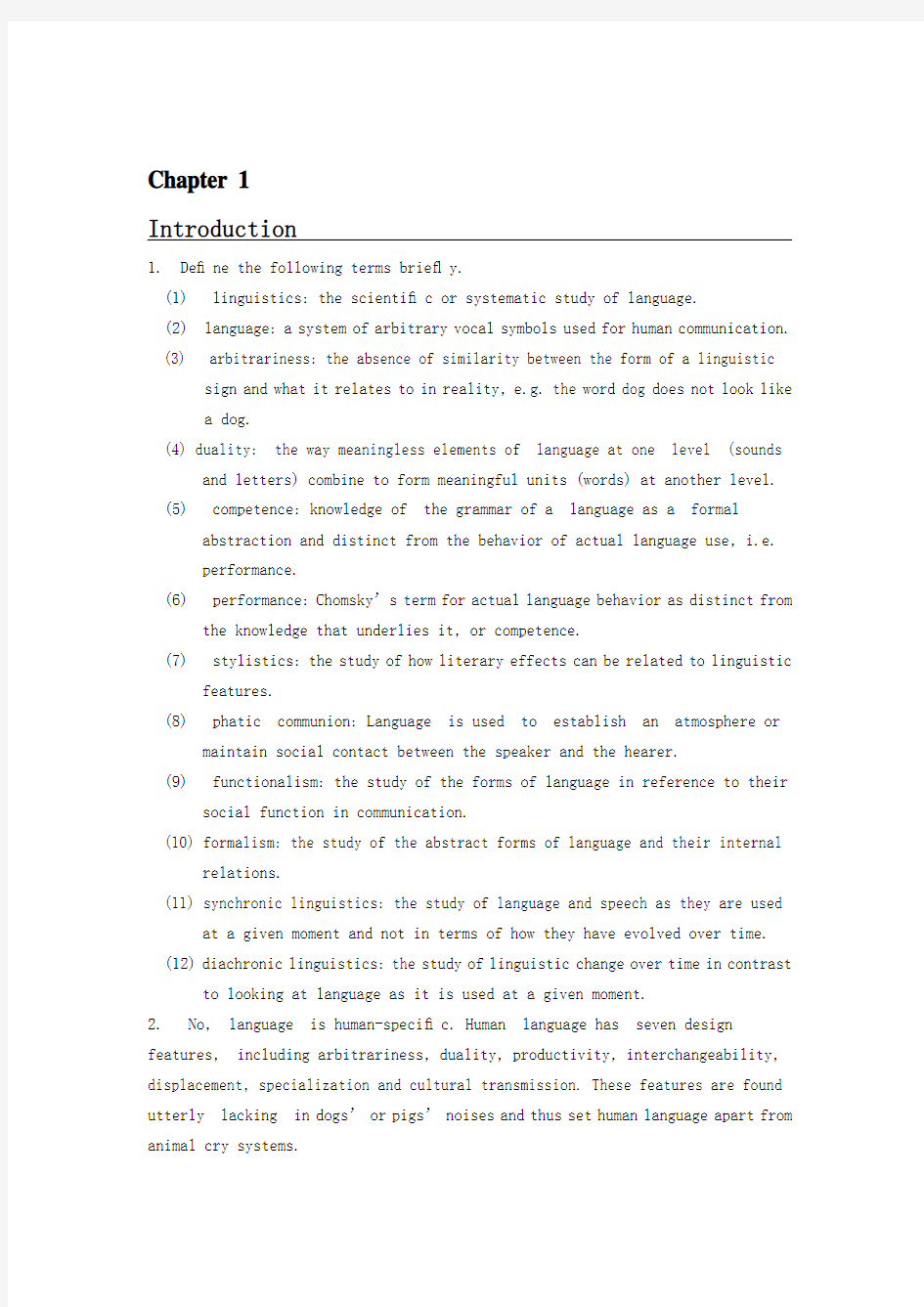语言学课后习题答案

- 1、下载文档前请自行甄别文档内容的完整性,平台不提供额外的编辑、内容补充、找答案等附加服务。
- 2、"仅部分预览"的文档,不可在线预览部分如存在完整性等问题,可反馈申请退款(可完整预览的文档不适用该条件!)。
- 3、如文档侵犯您的权益,请联系客服反馈,我们会尽快为您处理(人工客服工作时间:9:00-18:30)。
Chapter 1
Introduction 1. Define the following terms briefly.
(1) linguistics: the scientifi c or systematic study of language.
(2) language: a system of arbitrary vocal symbols used for human communication.
(3) arbitrariness: the absence of similarity between the form of a linguistic
sign and what it relates to in reality, e.g. the word dog does not look like
a dog.
(4) duality: the way meaningless elements of language at one level (sounds
and letters) combine to form meaningful units (words) at another level.
(5) competence: knowledge of the grammar of a language as a formal
abstraction and distinct from the behavior of actual language use, i.e.
performance.
(6) performance: Chomsky’s te rm for actual language behavior as distinct from
the knowledge that underlies it, or competence.
(7) stylistics: the study of how literary effects can be related to linguistic
features.
(8) phatic communion: Language is used to establish an atmosphere or
maintain social contact between the speaker and the hearer.
(9) functionalism: the study of the forms of language in reference to their
social function in communication.
(10) formalism: the study of the abstract forms of language and their internal
relations.
(11) synchronic linguistics: the study of language and speech as they are used
at a given moment and not in terms of how they have evolved over time.
(12) diachronic linguistics: the study of linguistic change over time in contrast
to looking at language as it is used at a given moment.
2. No, language is human-specifi c. Human language has seven design features, including arbitrariness, duality, productivity, interchangeability, displacement, specialization and cultural transmission. These features are found utterly lacking in dogs’ or pigs’ noises and thus set human language apart from animal cry systems.
3. Arbitrariness refers to the fact that there is no logical or intrinsic connection bet ween a particular sound and the meaning it is associated with. For example, for the same animal dog, in English we call it /d0g/, in Chinese as “gou”, but “yilu” in Japanese; it barks wow wow in English but wang wang in Chinese. Of course, onomatopoetic words such as “quack-quack” and “bang” are exceptions, but words like these are relatively few compared with the total number of words in a language.
4. A human baby does not speak any language at birth. What language the baby is going to speak is determined by the culture he is born into. A Chinese baby born and brought up in London by an English family will speak English, while an English child brought up in Beijing by a Chinese aunt will speak Chinese. That is to say, language cannot be transmitted through heredity. It is culturally transmitted.
5. Firstly, linguistics describes languages and does not lay down rules of correctness while traditional grammar emphasizes correctness. Secondly, linguistics regards the spoken language as primary, while traditional grammar emphasizes the priority of the written language. Thirdly, traditional grammar is based on Latin and it tries to impose the Latin categories and structures on other languages, while linguistics describes each language on its own merits.
6. A descriptive approach attempts to tell what is in the language while the prescriptive approach tells people what should be in the language. Most modern linguistics is descriptive, whereas traditional grammars are prescriptive.
7. Synchronic linguistics studies language at one particular time while diachronic linguistics studies language developments through time. Synchronic linguistics focuses on the state of language at any point in history while diachronic linguistics focuses on the differences in two or more than two states of language over decades or centuries.
8. No, human language has the design feature of specialization. It refers to the fact that man does not have a total physical involvement in the act of communication. For example, a mother can tell a story to her child while slicing up a cake. However, wolves can only respond to a stimulus and is totally involved physically in the communication process. Thus, a wolf cannot have a language similar to man’s, even though it could express a thousand different emotions. Besides, the aspect of productivity also distinguishes human language from wolf ’s postures.
